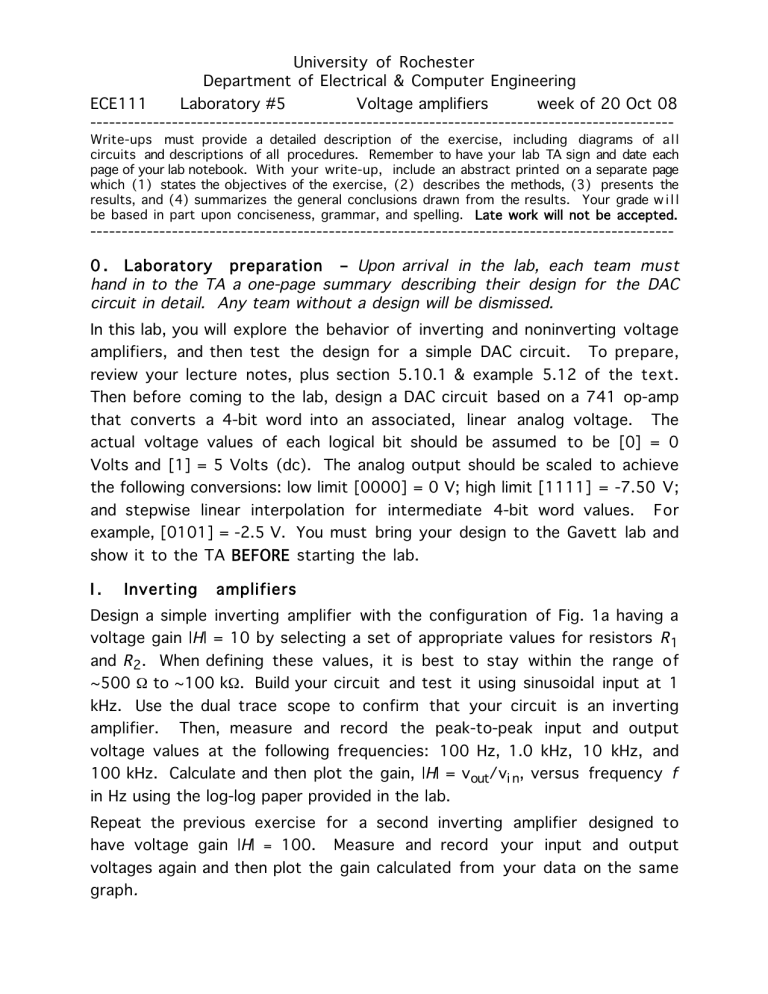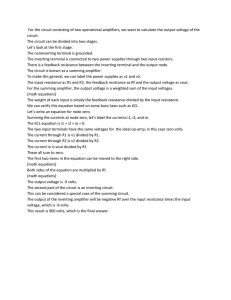Lab #5 - Electrical and Computer Engineering

University of Rochester
Department of Electrical & Computer Engineering
ECE111 Laboratory #5 Voltage amplifiers week of 20 Oct 08
---------------------------------------------------------------------------------------------
Write-ups must provide a detailed description of the exercise, including diagrams of a l l circuits and descriptions of all procedures. Remember to have your lab TA sign and date each page of your lab notebook. With your write-up, include an abstract printed on a separate page which (1) states the objectives of the exercise, (2) describes the methods, (3) presents the results, and (4) summarizes the general conclusions drawn from the results. Your grade w i l l be based in part upon conciseness, grammar, and spelling. Late work will not be accepted.
---------------------------------------------------------------------------------------------
0 . Laboratory preparation – Upon arrival in the lab, each team must hand in to the TA a one-page summary describing their design for the DAC circuit in detail. Any team without a design will be dismissed.
In this lab, you will explore the behavior of inverting and noninverting voltage amplifiers, and then test the design for a simple DAC circuit. To prepare, review your lecture notes, plus section 5.10.1 & example 5.12 of the text.
Then before coming to the lab, design a DAC circuit based on a 741 op-amp that converts a 4-bit word into an associated, linear analog voltage. The actual voltage values of each logical bit should be assumed to be [0] = 0
Volts and [1] = 5 Volts (dc). The analog output should be scaled to achieve the following conversions: low limit [0000] = 0 V; high limit [1111] = -7.50 V; and stepwise linear interpolation for intermediate 4-bit word values. For example, [0101] = -2.5 V. You must bring your design to the Gavett lab and show it to the TA BEFORE starting the lab.
I .
Inverting amplifiers
Design a simple inverting amplifier with the configuration of Fig. 1a having a voltage gain | H| = 10 by selecting a set of appropriate values for resistors R
1 and R
2
. When defining these values, it is best to stay within the range of
~500
Ω
to ~100 k
Ω
. Build your circuit and test it using sinusoidal input at 1 kHz. Use the dual trace scope to confirm that your circuit is an inverting amplifier. Then, measure and record the peak-to-peak input and output voltage values at the following frequencies: 100 Hz, 1.0 kHz, 10 kHz, and
100 kHz. Calculate and then plot the gain, | H| = v out
/v i n
, versus frequency f in Hz using the log-log paper provided in the lab.
Repeat the previous exercise for a second inverting amplifier designed to have voltage gain | H|
=
100. Measure and record your input and output voltages again and then plot the gain calculated from your data on the same graph .
- 2/ 5 -
R
1
+
-
R
2
R
1
+
-
R
2 v in v out v out v in a) Inverting amp
Fig. 1. Simple op-amp based voltage amplifier circuits. a) standard inverting voltage amplifier configuration. b) standard non-inverting voltage amplifier configuration.
b) Non-inverting amp
You can expect that the higher gain amplifier will not perform as well at the higher frequencies, and you will learn why this is so in ECE113.
Note: The 741 op-amp has a slew rate of ~0.3 to 0.7 V/µs @ unity gain, meaning that a 10x amplifier probably will not perform well above ~10 kHz for an input voltage of ~2 V p-p. For this reason, it is a good idea to limit the input to 0.1 V. You will know that you have encountered the slew rate limit if the output starts to look like a triangle wave for a sinusoidal (or any other periodic input) waveform.
II.
Noninverting amplifier
Design a simple noninverting amplifier with the configuration of Fig. 1b having voltage gain | H| =20 by choosing a set of appropriate values for R
1
and R
2
First use the scope to confirm that your circuit is a noninverting amplifier.
.
Next, measure and record peak-to-peak input and output voltage values at
100 Hz, 1 kHz, 10 kHz, and 100 kHz. Use this data to calculate the experimental voltage gain | H| and then plot it on the same log-log paper used for the inverting amplifier data. In your plots, please be sure to distinguish clearly the data for the three amplifiers you have built. Figure a way to represent graphically the uncertainties for your voltage gain data.
III.
Digital-to-analog converter (DAC)
Build the DAC design that you have designed on your proto board using a 741 op-amp and then test the circuit. For input, you are to use the ECE112 logic boards available in the lab. Make sure to connect each logical output to the correct resistor in the summing amplifier. Ask the TA how to wire the LEDs
- 3/ 5 on the logic boards to get a visual display of the 4-bit binary word. Copy the table found below into your lab notebook; then take the measurements necessary to fill in the measured data and record the data in this table.
NOTE: part of the assignment here to account for the uncertainties encountered for all output voltages actual measured.
n binary input design output v o u t measured v o u t
& ±uncertainty
[0111]
[1000]
[1001]
[1010]
[1011]
[1100]
[1101]
[1110]
[0000]
[0001]
[0010]
[0011]
[0100]
[0101]
[0110]
11
12
13
14
9
10
7
8
5
6
3
4
0
1
2
5.5 V
6.0 V
6.5 V
7.0 V
3.5 V
4.0 V
4.5 V
5.0 V
0.0 V
0.5 V
1.0 V
1.5 V
2.0 V
2.5 V
3.0 V
15 [1111] 7.5 V
If you find that your DAC does not work satisfactorily, try to diagnose the problem and change the design as needed to get it working correctly.
- 4/ 5 -
IV.
Extra credit – start this only after you have finished sections I, II, and III.
Design and test a second digital-to-analog converter with a bipolar output that is linearly related to the difference between two 4-bit binary words, that is, [A] – [B], over the bipolar range from –7.5 V to +7.5 V. Examples:
• for [A] = [1000] & [B] = [0111], then v out
= +0.5 Volts
• for [A] = [0100] & [B] = [1100], then v out
= -2.0 Volts
• for any [A] = [B], then v out
= 0.0 Volts
Design your circuit using a cascaded pair of operational amplifiers as shown in Fig. 2. The design task consists of determining the values of all the resistors. As before, assume that the logic board voltage values associated with the binary logical values are [0] = 0 Volts and [1] = 5 Volts.
[A]
+
-
+
v out
[B]
Fig. 2. One possible design for a differencing digital-to-analog converter based on two op-amps. You are to design the circuit so that the analog output voltage v out
reflects the difference [ A] – [B].
You should appreciate that, for this circuit, there are 16 2 = 256 possible input combinations; therefore, it is quite impractical to test the response to all the possible input states. Compromise by testing your DAC for a representative set of carefully selected input states (~15 total) that span the full range of output values. Present your data in a table format similar to the one found in section III and compare predictions to measurements.
- 5/ 5 -
ECE111 Logic Boards
The logic boards have 8 bits individually controlled by two position toggle switches. The outputs are complements. If A = True, then B = False and vice versa.
+5 V nand gates toggle switch B
A
A out
B out
••••••••
••••••••
16 pin socket
True = +5 V
False = 0 V
+5 V
ECE112 logic board binary TTL
These boards have a set of 8 LEDs that can be used to provide a visual display of the binary word values. Connect a wire from the appropriate pin of the output socket to the desired pin of the LED socket.

